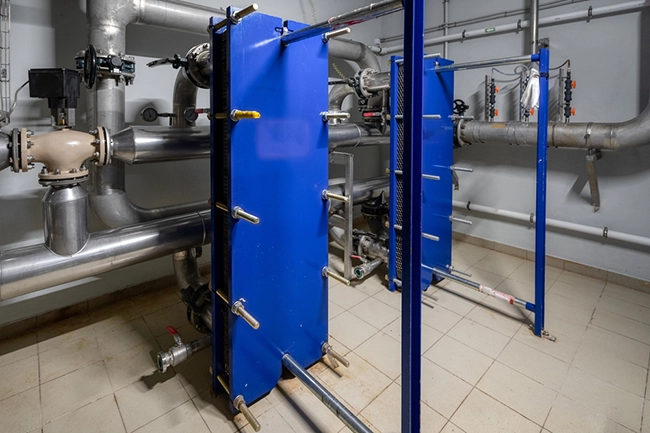Plate heat exchangers (often abbreviated to PHX) are critical components in many industrial and commercial heating systems, especially in packaged boilers. They play a vital role in enhancing the efficiency of these boilers by facilitating the transfer of heat from one fluid to another. In this article, we will explore the inner workings of a plate heat exchanger in the context of a packaged boiler and how this technology improves the overall performance of the system.
Understanding Plate Heat Exchangers (PHX)
A plate heat exchanger is a compact device that consists of multiple thin, corrugated metal plates, usually made from stainless steel or another suitable material. These plates are aligned and clamped together, forming alternating channels for two different fluids. The hot fluid, typically water or steam in the context of a packaged boiler, flows through some of these channels, while the cooler fluid, such as water or a heat transfer fluid, flows through the others.

How Does It Work?
The operation of a plate heat exchanger can be broken down into several key steps:
Flow Distribution: The hot fluid enters the plate heat exchanger through one of the inlet ports and is distributed into the hot fluid channels. The fluid flows over one side of the plates, transferring its heat to the metal.
Heat Transfer: As the hot fluid flows over the plates, it heats up the metal plates. Simultaneously, the cooler fluid enters the exchanger through its own inlet and is distributed into the cooler fluid channels on the other side of the plates. The heat from the metal plates is transferred to the cooler fluid through the thin plate walls.
Turbulent Flow: The corrugated design of the plates promotes turbulent flow within the channels, which maximises the heat transfer efficiency. Turbulence ensures that the fluid flows in close contact with the heated plate surface, optimising the heat exchange process.
Outlet Ports: The now heated cooler fluid exits the plate heat exchanger through the outlet port, ready for its intended use, such as space heating or industrial processes. The cooled hot fluid, having given up its heat, exits the exchanger through its own outlet.
Key Advantages of Plate Heat Exchangers in Packaged Boilers
High Efficiency: Plate heat exchangers are highly efficient at transferring heat from one fluid to another, making them an excellent choice for improving the overall efficiency of packaged boilers.
Compact Design: Their compact and lightweight design allows for easy integration into the limited space of a packaged boiler, making them a space-efficient choice.
Easy Maintenance: Plate heat exchangers are easy to access and maintain. In case of fouling or scaling, the plates can be removed, cleaned, or replaced without the need to disassemble the entire boiler.
Versatility: Plate heat exchangers are suitable for various heat transfer applications, offering versatility in boiler systems.
Plate heat exchangers are indispensable components in packaged boilers, helping to boost efficiency and reduce energy consumption by efficiently transferring heat between fluids. Their ability to facilitate quick and efficient heat exchange makes them a popular choice for industrial and commercial heating systems. With their compact design, ease of maintenance, and versatility, plate heat exchangers play a crucial role in ensuring that packaged boilers operate at their peak performance, ultimately saving energy and operational costs for businesses and industries.
Can you hire a plate heat exchanger?
Yes, Rapid Energy stocks plate heat exchangers that are available for hire. They can be hired in isolation or as a part of a temporary boiler solution. They are often utilised to provide a hot water solution. If you require a plate heat exchanger, speak with a member of our team today on 0800 464 7025.











